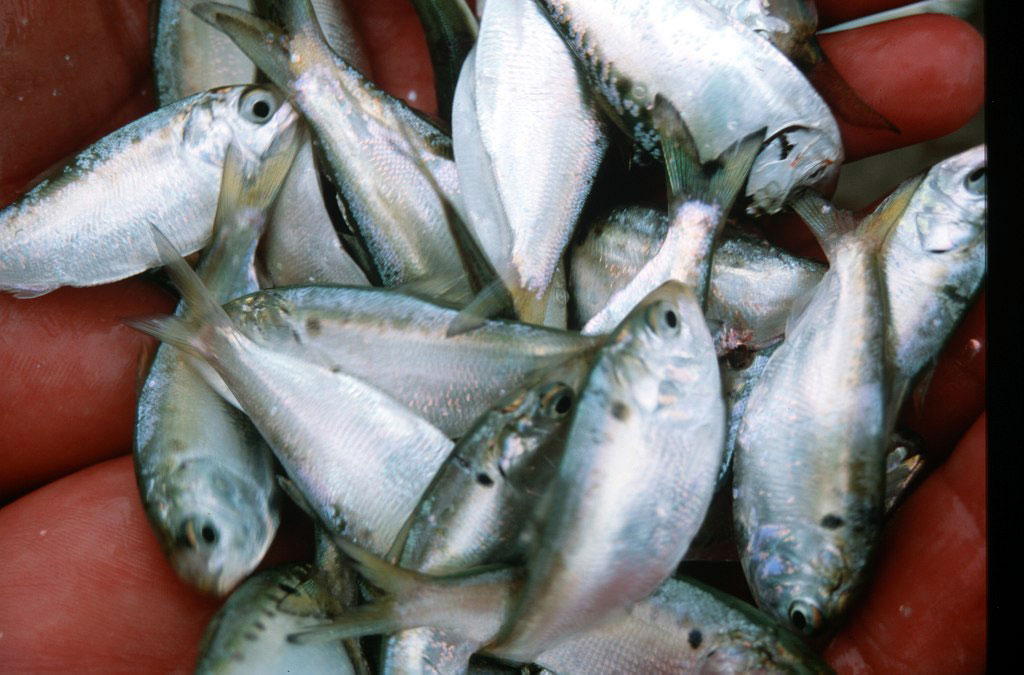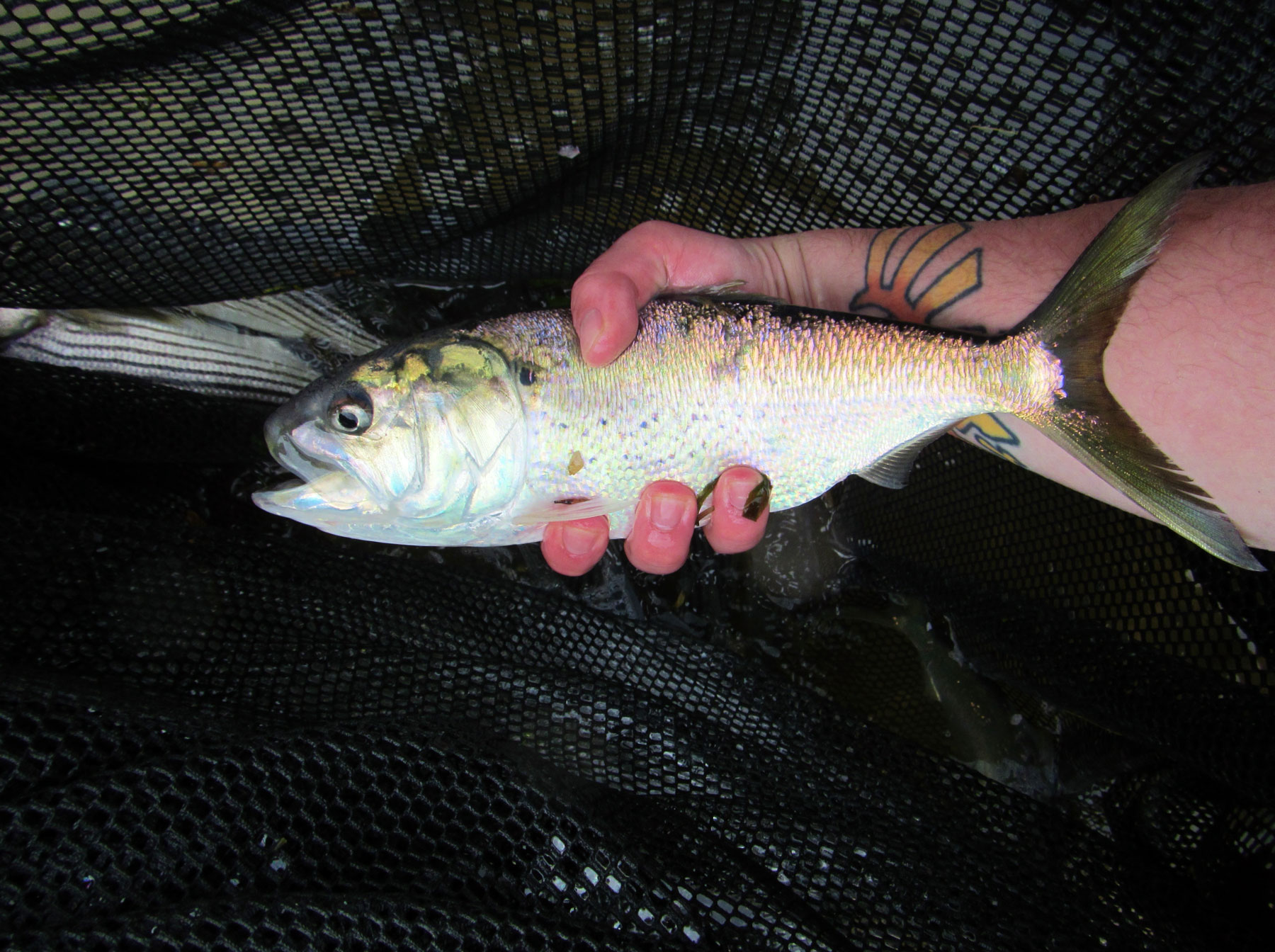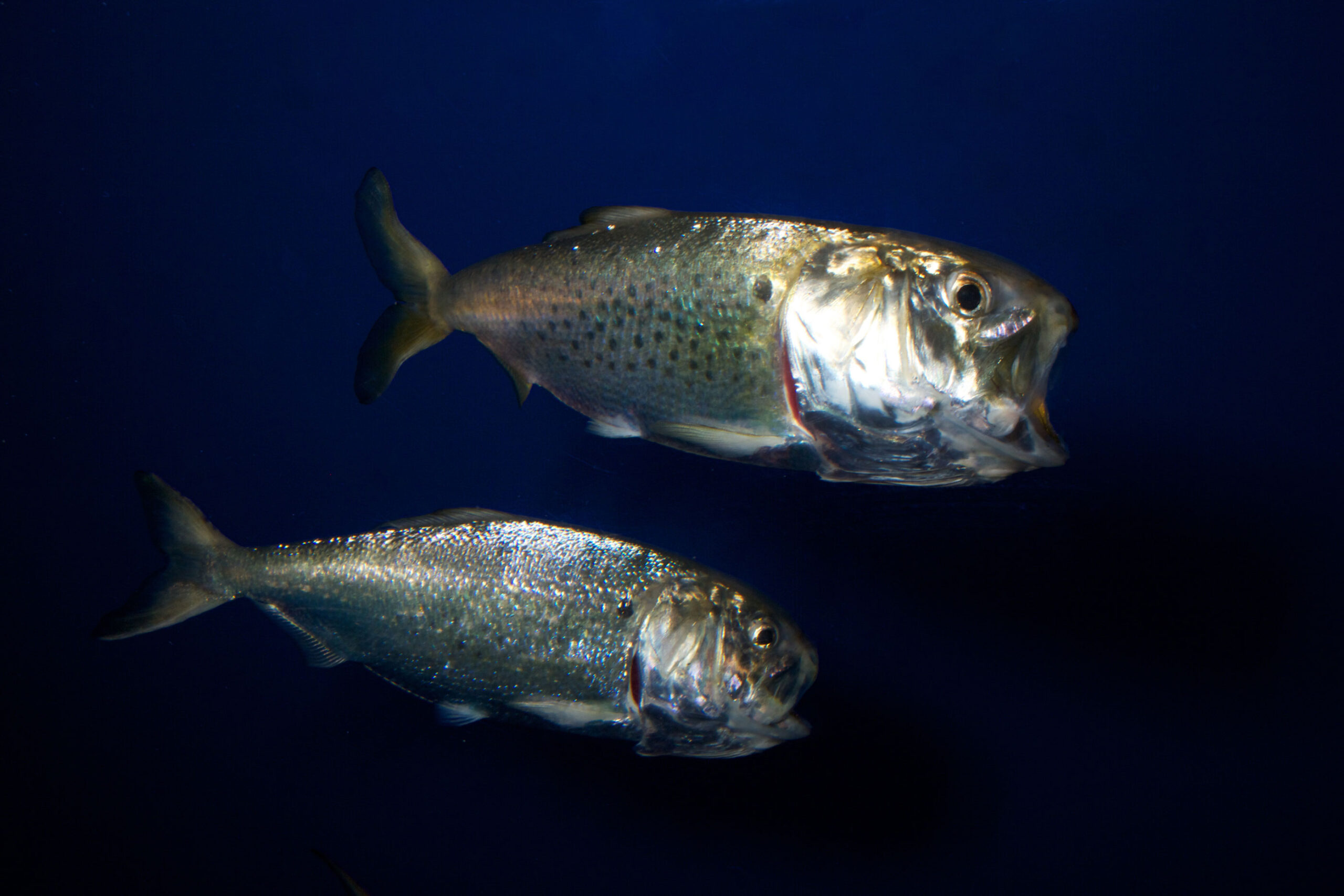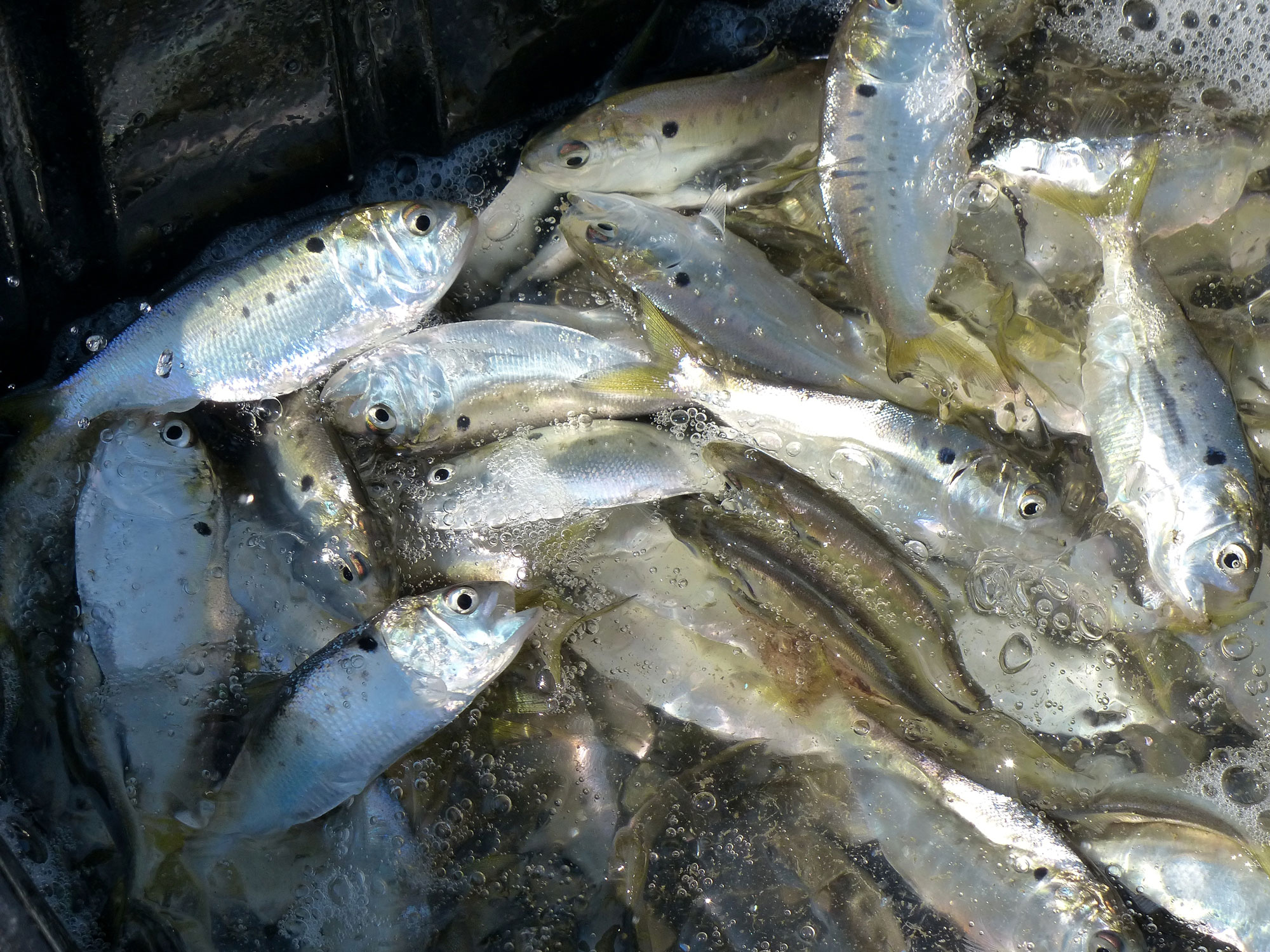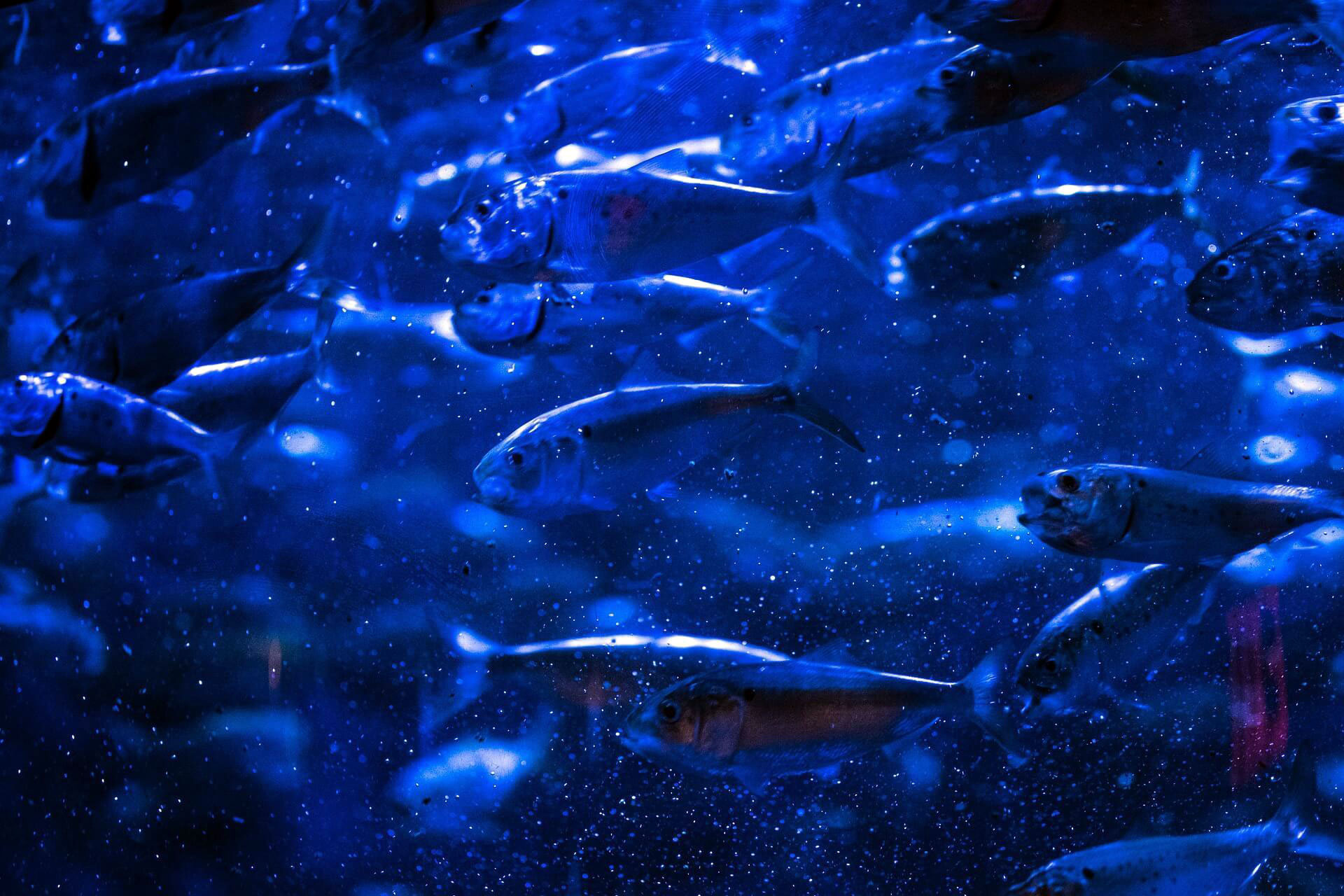Atlantic Menhaden

Latest News and Resources
-
Atlantic Menhaden Management Board Annual Meeting Supplemental 2 Materials — October 2025
-
Atlantic Menhaden Management Board Annual Meeting Supplemental Materials — October 2025
-
2025 Annual Meeting Agenda and Public Comment Guidelines
-
Atlantic Menhaden Management Board Annual Meeting Materials — October 2025
-
2025 Annual Meeting Travel Authorization
-
2025 Annual Meeting Notice and Preliminary Agenda
-
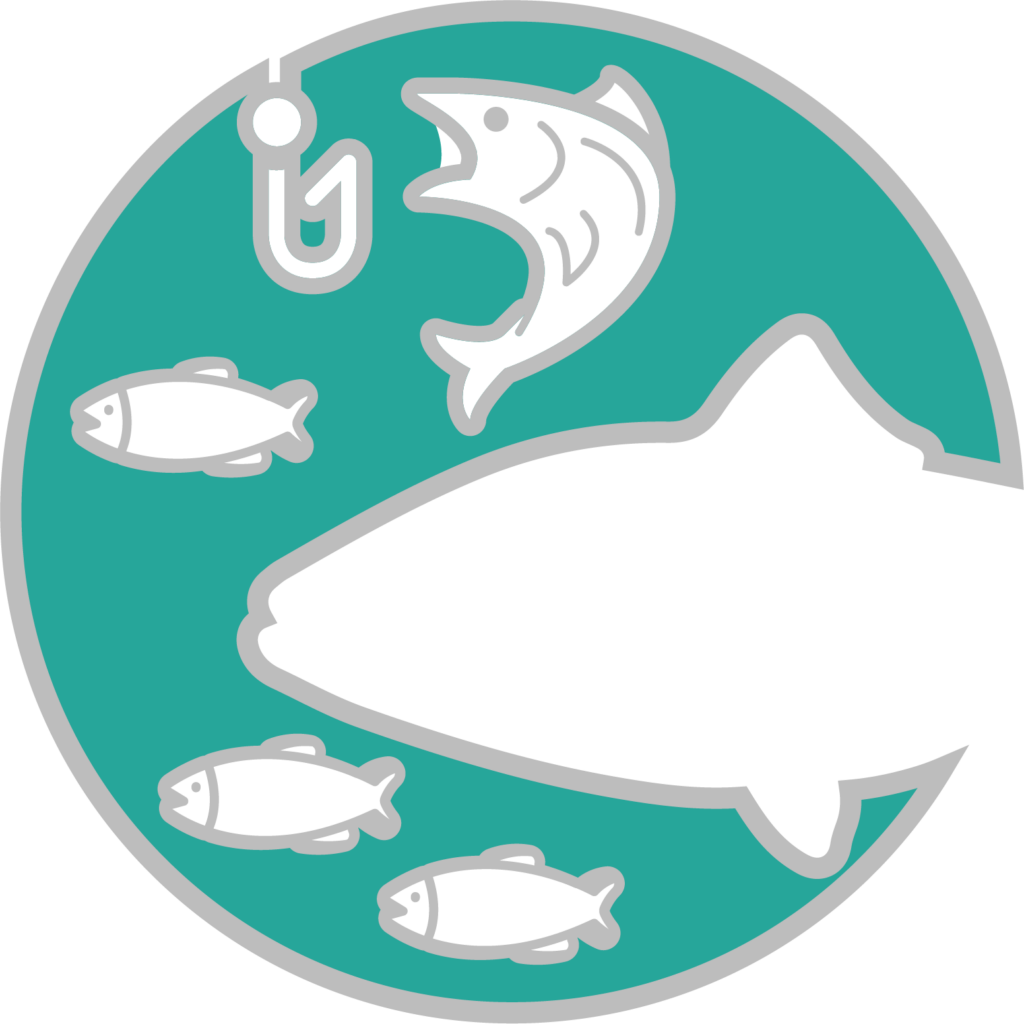
Population Abundance
Not overfished
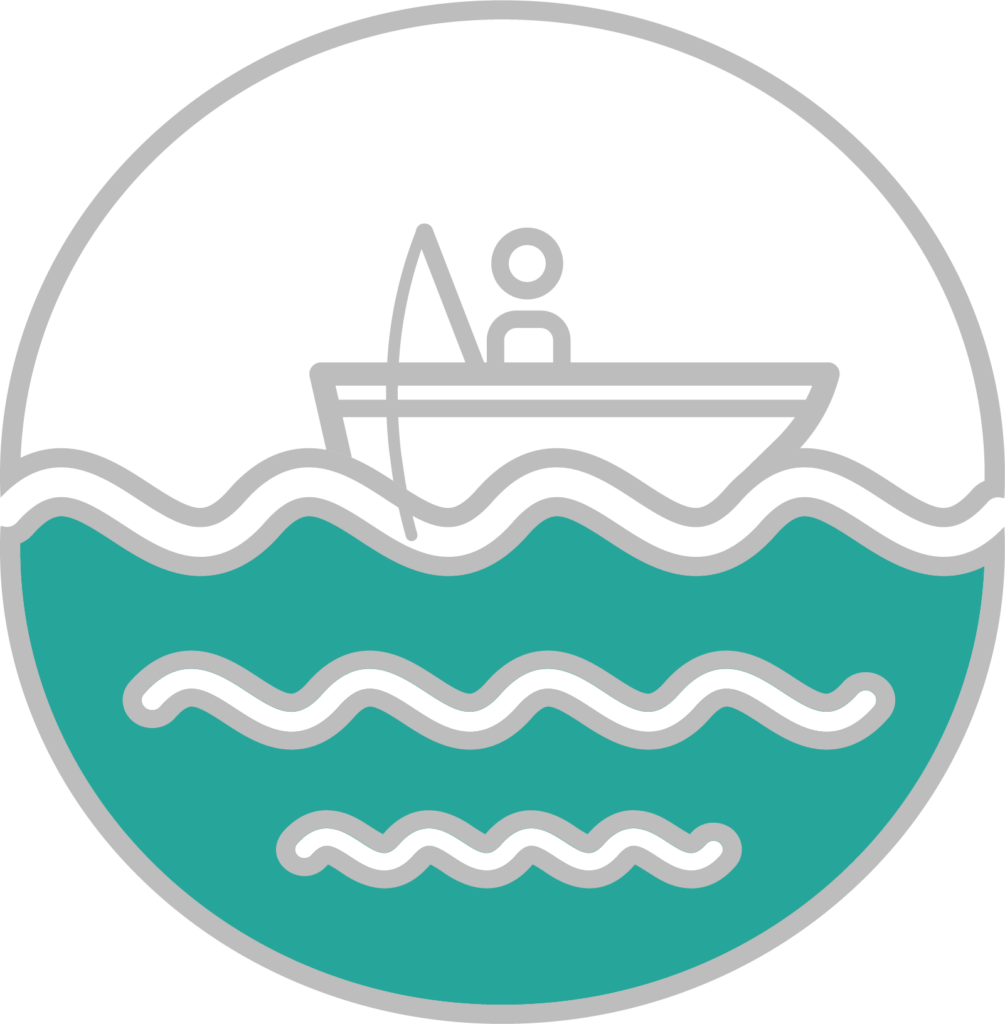
Fishing Mortality
Overfishing not occurring
Current Status
Stock status based on 2022 assessment update. Use of ecological reference points (ERPs) implemented in 2020. Single-species assessment update and ERP benchmark assessment and peer review scheduled for 2025.
Meeting Calendar
Next Meeting
Contacts
- James Boyle IV, FMP Coordinator (JBoyle@asmfc.org)
- Management Board, John Clark, Chair
- Technical Committee, Caitlin Craig, Chair
- Advisory Panel, Meghan Lapp, Chair
Species Information
Atlantic menhaden are a crucial forage species in the Atlantic coastal ecosystem, supporting a wide range of predators including striped bass, bluefish, and weakfish. Managed under a comprehensive Interstate Fishery Management Plan, Atlantic menhaden fisheries balance commercial reduction and bait harvests with ecosystem-based approaches to ensure healthy populations. Through advanced stock assessments and ecological reference point strategies, the Commission works to sustain this vital species while supporting the fisheries and communities that depend on them.
Management
Atlantic menhaden are currently managed under Addendum I to Amendment 3 to the Interstate Fishery Management Plan (FMP). Addendum I addresses commercial allocations, the Episodic Event Set Aside (EESA) Program, and the Incidental Catch/Small-Scale Fishery (IC/SSF) Provision. Regarding allocations, the Addendum creates a three-tiered system for minimum allocations to the states, with Pennsylvania receiving 0.01%; South Carolina, Georgia, Connecticut, Delaware, North Carolina, and Florida receiving 0.25%; and the remaining states continuing to receive a minimum of 0.5%. Furthermore, the Addendum allocates the remainder of the TAC, excluding the 1% for episodic events in the states of New York through Maine under the EESA Program, on a state-by-state basis based on landings history of the fishery from 2018, 2019, and 2021.

Under the IC/SSF provision, the Addendum codifies the ability for states to elect to divide their quotas into sectors, enabling individual sectors to enter into the provision at different times. Additionally, the Addendum removes purse seines as a permitted small-scale directed gear, thereby, prohibiting them from harvesting under the IC/SSF provision. Finally, the Addendum counts IC/SSF landings against the TAC and if IC/SSF landings cause the TAC to be exceeded, then the Board must take action to modify one or both of permitted gear types and trip limits under the provision. The Addendum also continues to prohibit the rollover of unused quota, maintains the 6,000 pounds trip limit for applicable gear types following the closure of a directed fishery, and keeps the current Chesapeake Bay Cap, which was first implemented in 2006 to limit the amount of reduction harvest within the Bay, at 51,000 mt. This recognizes the importance of the Chesapeake Bay as nursery grounds for many species by capping reduction landings from the Bay to current harvest levels.
The current TAC for the 2023 through 2025 fishing seasons is 233,550 mt, which is an approximate 20% increase from the 2021-2022 TAC based on the positive stock status of the resource under ecological reference point-based management. According to Technical Committee analysis, this increase has a less than 40% probability of exceeding the target set by the ecological reference points (ERPs) adopted in 2020. Given the positive results of the 2022 Stock Assessment Update, the Board approved this modest increase to provide additional fishing opportunities, while maintaining a conservative risk level of exceeding the ERP target.
Stock Status
In February 2020, the Board accepted the results of the Atlantic Menhaden Single-Species and Ecological Reference Point (ERP) Assessments and Peer Review Reports for management use. The single-species assessment acts as a traditional stock assessment using the Beaufort Assessment Model (BAM), and indicates the stock is not overfished or experiencing overfishing relative to the current single-species reference points.
The ERP assessment evaluates the health of the stock in an ecosystem context, and indicates that the fishing mortality (F) reference points for menhaden should be lower to account for menhaden’s role as a forage fish. The ERP assessment uses the Northwest Atlantic Coastal Shelf Model of Intermediate Complexity for Ecosystems (NWACS-MICE) to develop Atlantic menhaden ERPs. NWACS-MICE is an ecosystem model that focuses on four key predator species (striped bass, bluefish, weakfish, and spiny dogfish) and three key prey species (Atlantic menhaden, Atlantic herring, and bay anchovy).
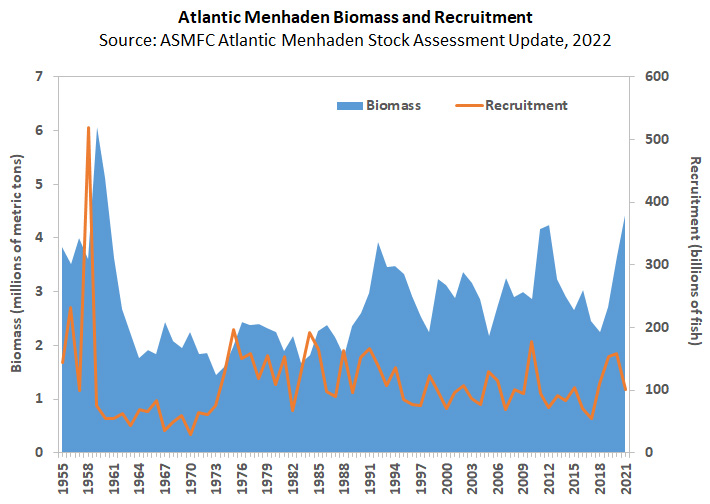
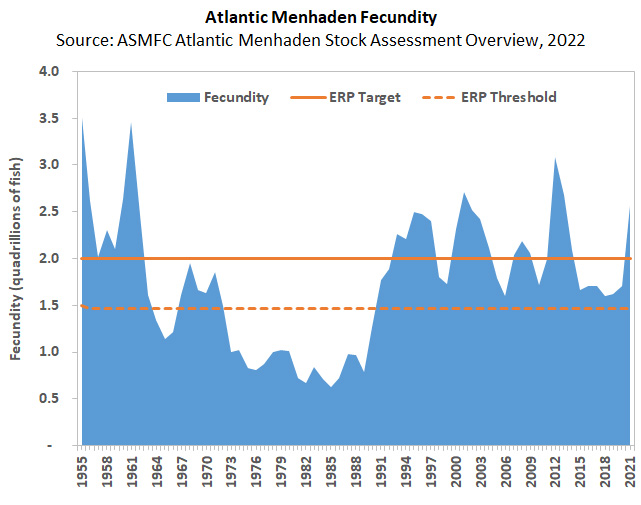
These species were chosen because diet data indicate they are top predators of Atlantic menhaden or are key alternate prey species for those predators. A more detailed overview of the stock assessments is available here. This tool allows managers to evaluate the tradeoffs between Atlantic menhaden harvest and predator abundance to set reference points that take into account menhaden’s role as a forage fish.
In August 2020, the Board approved the following ERPs in the management of Atlantic menhaden:
- ERP target: the maximum fishing mortality rate (F) on Atlantic menhaden that sustains Atlantic striped bass at their biomass target when striped bass are fished at their F target
- ERP threshold: the maximum F on Atlantic menhaden that keeps Atlantic striped bass at their biomass threshold when striped bass are fished at their F target.
- ERP fecundity target and threshold: the long-term equilibrium fecundity that results when the population is fished at the ERP F target and threshold, respectively
Atlantic striped bass was the focal species for the ERP definitions because it was the most sensitive predator fish species to Atlantic menhaden harvest in the model, so an ERP target and threshold that sustained striped bass would likely provide sufficient forage for other predators under current ecosystem conditions. For the development of the ERPs, all other focal species in the model (bluefish, weakfish, spiny dogfish, and Atlantic herring) were assumed to be fished at 2017 levels.
For more information about our efforts to develop and implement ERPs for Atlantic menhaden, check out our story map. Scroll through photos and figures to better understand what ERPs are, how they are used in the management of menhaden, and how they work towards achieving ecosystem approaches to fisheries management.
In August 2022, the Board accepted the results of the Single-Species Update Assessment. Under the ERPs, Atlantic menhaden are neither overfished nor experiencing overfishing. In 2021, population fecundity (FEC), a measure of reproductive capacity of the population, was above the ERP threshold and target (FEC2021/FECERPThreshold = 1.76; FEC2021/FECERPTarget = 1.28), and fishing mortality (F) was below the ERP overfishing threshold and target (F2021/FERPThreshold = 0.28; F2021/FERPTarget = 0.85). A more detailed overview of the stock assessment update can be found here.
Commercial & Recreational Fisheries
The Atlantic menhaden commercial fishery consists of a reduction fishery (named because it “reduces” the whole fish into fish meal, fish oil, and fish solubles) and a bait fishery. The reduction fishery first began in New England during the early 1800s and spread south after the Civil War. The reduction fishery grew with the advent of purse seines in the mid-1800s and reached peak landings in 1956 at 712,100 metric tons (mt). At the time, over 20 menhaden reduction factories ranged from southern Maine to northern Florida.
In the 1960s, the Atlantic menhaden stock contracted geographically, and many of the reduction factories north of the Chesapeake Bay closed due to a scarcity of fish. Consequently, reduction landings dropped to 161,000 mt in 1969. In the 1970s and 1980s, the menhaden population began to expand (primarily due to a series of above average year classes entering the fishery), and reduction landings rose to around 300,000-400,000 mt. Adult menhaden were again abundant in the northern half of their range and, as a result, reduction factories in Canada and New England began processing menhaden again by the mid-1970s. However, by 1989 all shore-side reduction plants in New England had closed, mainly because of odor abatement regulations.
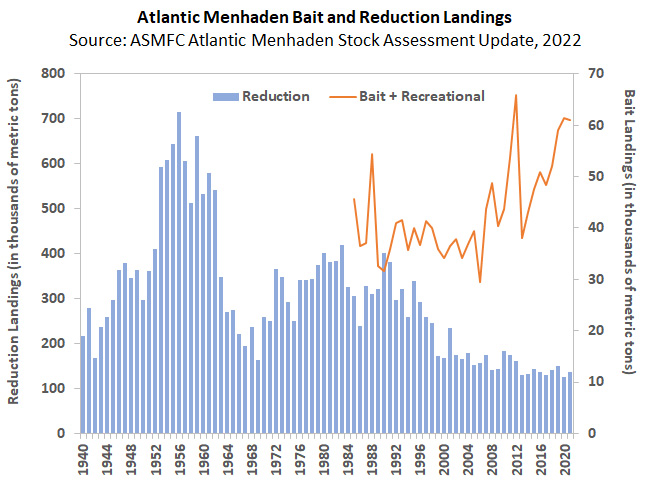
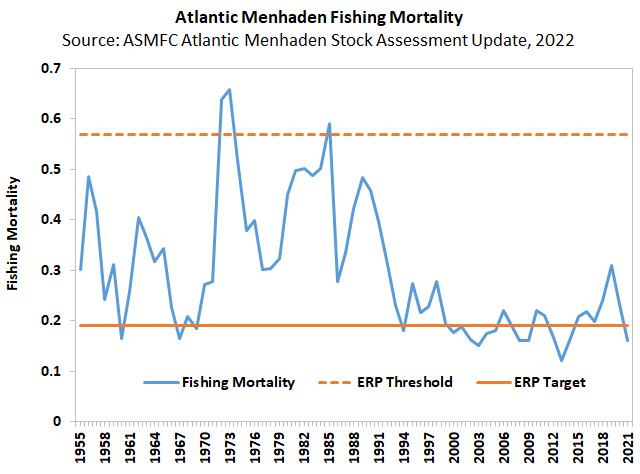
During the 1990s, the Atlantic menhaden stock contracted again, largely due to a series of poor to average year classes. Over the next decade, several reduction plants consolidated or closed, resulting in a significant reduction in fleet size and fishing capacity. By 2006, there was only one remaining reduction plant in operation on the Atlantic coast processing menhaden into fishmeal and oil. This is the Omega Protein plant, located in Reedville, Virginia, which is still operational today. In 2022, roughly 134 thousand mt were landed for reduction purposes.
While reduction landings have declined since the mid-2000s, menhaden landings for bait have become increasingly important to the total coastwide landings of menhaden. Commercial bait landings occur in almost every Atlantic coast state. A majority of bait landings are used commercially in crab, lobster, and hook-and-line fisheries. Recreational fishermen also catch Atlantic menhaden as bait for various game fish.
In contrast to reduction landings, bait landings have increased in recent years due to higher demand and increased menhaden availability in the northern part of the species’ range. Total bait landings along the Atlantic coast averaged 44,600 mt from 2005-2012 prior to the implementation of the TAC and have averaged 50,000 mt since then. Recreational landings (menhaden caught by anglers on recreational fishing trips, usually for bait) comprised 1% of the coastwide landings over that time period. In 2023, bait and recreational landings were 50,000 mt and comprised 30% of coastwide landings.
Commercial landings in 2022, including reduction, bait, bycatch, and episodic event landings, were 195,387 mt, which represents a 0.15% increase in landings from 2021.
Life History
Atlantic menhaden (Brevoortia tyrannus) occupy estuaries and coastal waters from Nova Scotia to northern Florida and are believed to consist of a single population. Adult and juvenile menhaden form large, near-surface schools, primarily in estuaries and nearshore ocean waters from early spring through early winter. By summer, menhaden schools stratify by size and age along the coast, with older and larger menhaden found farther north. During fall-early winter, menhaden of all sizes and ages migrate south around the North Carolina capes to spawn.
Sexual maturity begins as early as age one to just before age three, with major spawning areas from New Jersey to the Carolinas. The majority of spawning primarily occurs offshore (20-30 miles) during winter. Buoyant eggs hatch at sea, and larvae are carried into estuarine nursery areas by ocean currents. Juveniles spend most of their first year in estuaries, migrating to the ocean in late fall.
Menhaden are very efficient filter feeders. Water is pushed through specialized gill rakers that are formed into a basket that allows them to capture plankton. Menhaden are an important component of the food chain, providing a link between primary production and higher organisms by consuming plankton and providing forage for species such as striped bass, bluefish, and weakfish, to name just a few.
News & Resources
Explore recent news, management updates, and scientific reports to gain a deeper understanding of ongoing conservation efforts and sustainability strategies.
-
-
-
-
Consider 2025 Single-Species Assessment Update and Ecological Reference Point Benchmark Stock Assessment and Peer Review Report Action, Overview of Single-Species Assessment (C. Craig), Overview of Ecological Reference Point Assessment (M. Cieri), Presentation of Peer Review Report (S. Gaichas), Consider Acceptance of 2025 Stock Assessments and Peer Review Report for Management Use, Consider Management Response, If…
-
-
-
-
A summary of all the board meetings, press releases and motions from the 2025 Summer Meeting.
-
Discuss Technical Committee Direction in Response to Work Group Report on Precautionary Management in Chesapeake Bay; Progress Update on 2025 Ecological Reference Point Benchmark Stock Assessment
-
Combined materials for all Boards convening at the ASMFC Summer Meeting
-
Discuss Technical Committee Direction in Response to Work Group Report on Precautionary Management in Chesapeake Bay; Progress Update on 2025 Ecological Reference Point Benchmark Stock Assessment
-
Discuss Technical Committee Direction in Response to Work Group Report on Precautionary Management in Chesapeake Bay; Progress Update on 2025 Ecological Reference Point Benchmark Stock Assessment
-
-
-
The Atlantic States Marine Fisheries Commission’s Summer Meeting will be August 5-7, 2025 at The Westin Crystal City.
Get Hooked on ASMFC News
Dive into the latest updates and catch all the important news by joining our newsletter mailing list. Stay in the loop with meeting agendas, fisheries management news, and more.

